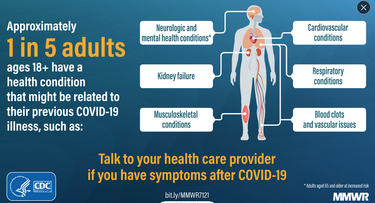CDC: Long COVID affects 1 in 5 adult survivors, more if over 64
ALBANY COUNTY — One in five COVID-19 survivors aged 18 to 64 years and one in four survivors aged 65 or older had at least one lingering condition that might be attributable to the virus, according to a study released this week by the Centers for Disease Control and Prevention.
The study also found that COVID-19 survivors have twice the risk for developing pulmonary embolism or respiratory conditions than people who haven’t had COVID.
The study was based on electronic health-record data from March 2020 to November 2021 to assess the incidence of 26 conditions often attributable to post-COVID among patients who had received a previous COVID-19 diagnosis compared with the incidence among matched patients without evidence of COVID-19 — the control patients.
The analysis was stratified by two age groups: from 18 to 64, and 65 and older. Patients were followed for 30 to 365 days after the index encounter until one or more incident conditions were observed or through Oct. 31, 2021 — whichever occurred first.
Among all patients, 38 percent of those who’d had the virus experienced an incident condition compared with 16 percent of the control group; conditions affected multiple systems, and included cardiovascular, pulmonary, hematologic, renal, endocrine, gastrointestinal, musculoskeletal, neurologic, and psychiatric signs and symptoms.
For those patients 65 and older, there was an increased risk for neurologic conditions, as well as for four of five mental health conditions (mood disorders, other mental conditions, anxiety, and substance-related disorders). Neurocognitive symptoms have been reported to persist for up to one year after acute infection and might persist longer, the report said.
Overall, 45.4 percent of the survivors aged 65 and older in this study had incident conditions. This age group is already at higher risk for stroke and neurocognitive impairment, so post-COVID conditions affecting the nervous system are of particular concern because these conditions can lead to early entry into supportive services or investment of additional resources into care, the report said.
The findings are consistent with those from several large studies that indicated that post-COVID incident conditions occur in 20 to 30 percent of patients, the report said, and that a proportion of patients require expanded follow-up care after the initial infection.
“COVID-19 severity and illness duration can affect patients’ health care needs and economic well-being ….,” the report said. “In addition, care requirements might place a strain on health services after acute illness in communities that experience heavy COVID-19 case surges.”
Albany County
Another Albany County resident — a man in his eighties — has died of COVID-19, Albany County Executive Daniel McCoy reported in a release on Friday. This brings the county’s COVID-19 death toll to 563.
On Friday, McCoy hosted a barbecue at the county’s nursing home to thank the National Guard members who have helped out there since January. Guard members were deployed statewide to make up for staff shortages at nursing homes during the pandemic.
“As we start the holiday weekend and people travel and gather together, I encourage you to remember the precautions outlined by the CDC if you are indoors, and to get vaccinated and boosted if you haven’t already,” said McCoy in his Friday release.
The CDC continues to label Albany County, like most of the counties in New York, as having a “high” community level of COVID, meaning masks should be worn indoors in public.
Governor Kathy Hochul in the daily COVID release from her office, had similar advice on Friday: “As New Yorkers travel to spend Memorial Day weekend with friends and family, it is important that we don’t let our guard down and continue to use the tools we have available to us to stay safe and healthy,” she said.
“The best way to protect yourself and your loved ones from serious illness is to get vaccinated and keep up to date with your booster doses,” she went on. “If you are experiencing symptoms, get tested, and if you test positive talk to your doctor about available treatments.”
A quarter of Albany County residents still have not completed a vaccination series.
The seven-day case rate across the state has declined over the last 10 consecutive days. In Albany County, too, after the surge caused by subvariants of Omicron peaked, the case rate continues to decline.
The state’s count of cases per 100,000 of population, as a seven-day average, peaked at 51.0 on May 11. It is now down to 41.41.
Albany County’s count of cases per 100,000 of population, as a seven-day average, peaked at 53.6 on May 19.
The most recent seven-day average of COVID cases per 100,000 is now down to 41.8 and the county has an average percent positive rate of 12.0 percent.
Forty-five county residents are currently hospitalized with the coronavirus, with seven in an intensive-care unit.



